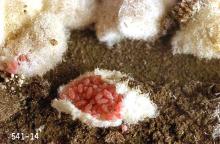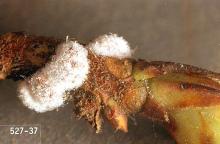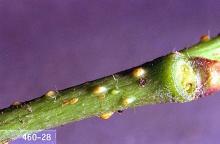Includes
Azalea bark scale (Eriococcus azaleae)
Lecanium scale (Toumeyella spp.)
Pest description and crop damage The lecanium scale overwinters on twigs and branches under a hard, helmet-like, reddish-brown covering, which is about 6-8 mm in diameter. The azalea bark scale overwinters on older twigs and branches, under a white, felt-like egg sac about 6-12 mm in diameter. In the spring, the eggs under the winter covering hatch, and young nymphs (crawlers) actively move about the plant and begin feeding on leaves and stems. Azalea bark scale nymphs are distinguished by their red color. Nymph feeding of both species can reduce the photosynthetic capability of the plant and cause weak growth and, possibly, a reduced crop the following year. A more direct damaging effect is the sooty mold (a black fungus) that grows on the honeydew secreted by the scale, rendering fruit unmarketable or of a lower value. Control requires thorough coverage with a drenching spray.
Scouting and thresholds Inspect twigs during the dormant season for scale. Pay particular attention to weak plants. The crawlers are best observed during May-July with a 10X magnifying glass. In spring, when the weather warms up, placing a sticky substance, such as double-stick tape, Tanglefoot, or a similar adhesive, around a branch above and below infestations of adult scale can easily "catch" crawlers as they migrate from their winter enclosures and indicate when crawlers are on the move and a good time to target control.
Management-biological control
Larvae of green lacewings are aggressive predators of scale.
Management-cultural control
Avoid excessive nitrogen fertilizer, as this favors increased scale populations.
Home gardeners: scale can be rubbed off plants by hand with a glove or toothbrush. Major infestations can be pruned off.
Management-chemical control: HOME USE
Chemical controls are timed to achieve control of either the overwintering scale or the crawlers.
Dormant-season spray
- dormant oil (98%)-Apply oil sprays while plants are dormant and when temperatures are above freezing. Some formulations are OMRI-listed for organic use.
Growing-season spray
- azadirachtin/neem oil-Some formulations are OMRI-listed for organic use.
- bifenthrin
- carbaryl
- horticultural oil
- insecticidal soap-Some formulations are OMRI-listed for organic use.
- malathion
- permethrin
- plant essential oils (cinnamon, garlic, peppermint, rosemary, thyme)-Some formulations are OMRI-listed for organic use.
- pyrethrins (often as a mix with other ingredients)-Some formulations are OMRI-listed for organic use.
- spinosad-Some formulations are OMRI-listed for organic use.
- zeta-cypermethrin-Toxic to bees; do not apply when bees are foraging.
Management-chemical control: COMMERCIAL USE
- azadirachtin (Neemix and other brands)-Consult label for rate. PHI 0 days. Some formulations are OMRI-listed for organic use.
- bifenthrin (Brigade and other brands) at 0.033 to 0.1 lb ai/A. PHI 1 day. Make a cover spray application when crawlers first emerge. (Group 3)
- horticultural oil (several brands)-Consult label for rate. Apply oil while plants are dormant and when temperatures are above freezing. Some formulations are OMRI-listed for organic use.
- insecticidal soap (M-Pede and other brands)-Consult label for rate and use directions. PHI 0 days. Apply when crawlers first emerge. Some formulations are OMRI-listed for organic use.
- malathion (several brands) at 1.25 lb ai/A. PHI 1 day. Apply when crawlers appear, as a spray in 100 gal water/A. After June, use 150 to 200 gal water/A. (Group 1)
- mineral oil (several brands)-Consult label for rate. Dormant spray.
- pyriproxyfen (Esteem) at 0.1 lb ai/A. PHI 7 days. Apply either at dormant or delayed-dormant for the overwintering stage, or as an in-season cover spray for control of the crawlers. At dormant or delayed-dormant, use with a horticultural oil. Make cover spray applications when scale crawlers first emerge. (Group 7)
- pyrethrins (PyGanic)-Consult label for rate. PHI 0 days. Do not apply during bloom.
- sulfoxaflor (Transform WG) at 0.086 lb ai/Ac. Suppression only. PHI 1 day. Toxic to bees for three hr following application. (Group 4)





